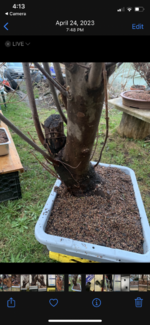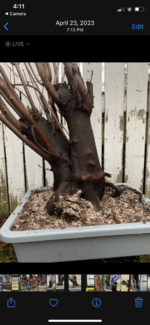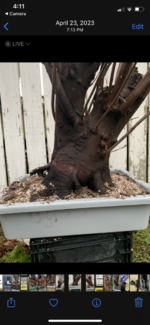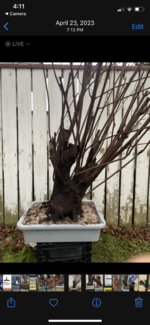I should try my hand at a few sugars.
Not really trying to rehash the first couple pages when choosing a tree to put the effort into to bonsai, one should think about the "bonsai traits" of the tree.
For example
Japanese maple, Acer palmatum (JM)
leaves that reduce well, especially with ramification and or a early summer defoliation
great foliage color, spring colors are vivid, autumn colors are outstanding for most seedling grown plants and especially so for select cultivars. Deciduous bonsai as an art was developed in part to showcase this species.
- ramification and short internodes - with JM very short nodes are possible. Fine branching is possible with time.
- Bark - generally smooth, this is a minor flaw, does not form fissured bark to add to the illusion of age. Except cultivars 'Arakawa' and 'Ibo can' and 'Ibo Nishiki' which have various degrees of warty to corky to fissured bark with age.
- hardiness - biggest fault with JM is winter hardiness. In the ground reliably hardy only through zone 6b, maybe 6a. Only a few clones are reliably hardy in zone 5a. Likely one reason 'Bloodgood' is everywhere is that it will survive a zone 5a winter in the ground. In a bonsai pot JM must be protected. They will not survive just set on the ground. This is their biggest weakness as bonsai, they need winter shelter. They are only good for the lower 35 states. Not good for northern tier growers unless they have heated winter storage.
So Japanese maple has strengths in leaf size, and color twice a year. Ramification is usually good, overall excellent bonsai material for zone 6b and warmer. Poor choice for bonsai in cold zone 5 and colder climates unless you have heated winter storage.
Silver maple - Acer saccharinum - Leaf color - green, and in autumn for a few hours yellow, then very quickly turns brown. Leaf size starts out large. Does reduce some, leaf petioles tend to remain out of proportion long, though they do reduce some too. Here 100% defoliation middle June or early July might be helpful.
- vigor of silver maple makes it tempting to work with. Very vigorous trees, will tolerate all manner of abuse.
- I have never been able to get short internodes in my few years of dabbling a couple decades ago. (pre digital photo era)
- bark is likely to develop nicely with time, a plated bark, not overly thick but definitely better in creating illusion of age than typical seedling JM
In my opinion, without the benefit of a persistent leaf color other than a few minutes of yellow in autumn, this species is not worth the time given that JM and Sugar Maple have MUCH better spring and autumn colors.
Now if you already have a Silver Maple in a pot or a grow box, go ahead and keep on working it, I am curious if someone can prove my conjecture wrong. Really, I would love to be proven wrong, but I don't have the energy to work with a tree without good fall color.
Sugar Maple - Acer saccharum - Has absolutely gorgeous autumn colors. Similar grow habit faults as the Silver Maple, but the benefit of beautiful autumn colors. Well worth the effort to "figure out". Go BIG or go abstract and really small. And definitely try defoliating a well established tree in late June or July to see how that helps with leaf reduction. It can become a "standard technique" for preparing for autumn shows. I had a JM that I would defoliate 100% 2 or 3 years out of 5 years. Then I would give it a break Never defoliated more than 2 summers in a row. But if the tree stays vigorous, maybe yearly defoliation would work well. Defoliation usually had to be 100% or else energy did not stay balanced through the JM. the area not defoliated would get coarse. Keep this in mind if you try defoliating on Sugar Maple. I have not tried defoliation on a sugar maple, so let the forum know how it works. Defoliation is a JM technique.
A western North American maple that has had some success as bonsai is Acer circinatum, the Vine Maple, it has been used by a number of the western USA bonsai artists like Michael Hagedorn and Ryan Neil. It is in the same subgenus as Acer palmatum, shares many traits with the JM. It does have larger leaves, it has good spring color and fabulous autumn colors. In many ways will look like a "full moon" JM, but it is native. Unfortunately being from middle and lower elevations of the Pacific temperate rain forests it is not any more winter hardy than a JM. Definitely a zone 6b and warmer when in a pot maple.
Acer ginnala also known as Acer tartaricum sub. ginnala - The Amur Maple. In many ways this one looks like a trident maple, except it is VERY COLD HARDY. In the ground it is hardy possibly into USDA Zone 2. This is a just set the pot on the ground for the winter maple. Leaves are not too big, Small, pretty close in size to that of a trident maple. Leaf colors are green in spring and summer, and a pretty yellow with touches of orange or red in autumn. Some seedlings tend to be very red in autumn. Internodes reduce well. This is an IDEAL maple for northern growers. If you have cold winters, try this maple .
If you have not got one, I highly recommend giving an Amur maple a try, they ARE worth the time.







